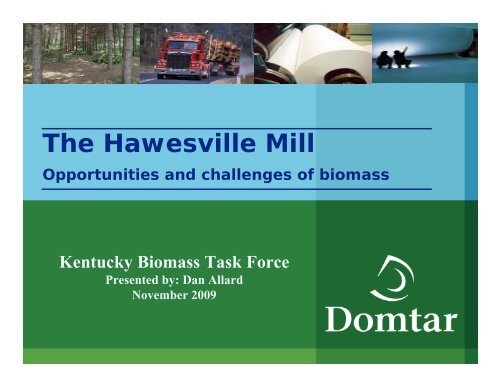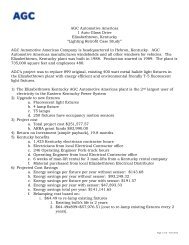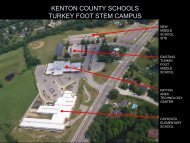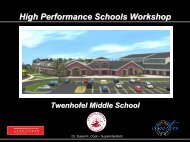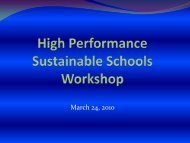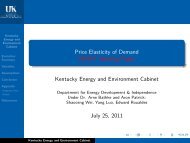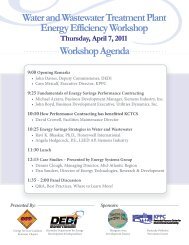The Hawesville Mill - Department for Energy Development and ...
The Hawesville Mill - Department for Energy Development and ...
The Hawesville Mill - Department for Energy Development and ...
Create successful ePaper yourself
Turn your PDF publications into a flip-book with our unique Google optimized e-Paper software.
<strong>The</strong> <strong>Hawesville</strong> <strong>Mill</strong><br />
Opportunities <strong>and</strong> challenges of biomass<br />
Kentucky Biomass Task Force<br />
Presented by: Dan Allard<br />
November 2009
<strong>The</strong> <strong>Hawesville</strong> <strong>Mill</strong><br />
• WILLAMETTE’S BEGINNING IN<br />
KENTUCKY MEDIUM MILL<br />
(WESCOR) - 1967<br />
• MEDIUM MILL AND<br />
BLEACHED PULP MILL IN<br />
OPERATION -1969<br />
• 1981 Fine Paper<br />
Machine (upper right<br />
h<strong>and</strong> corner)<br />
• HAWESVILLE MILL TODAY<br />
• Second Fine Paper machine<br />
added in 1998<br />
2
<strong>The</strong> <strong>Hawesville</strong> <strong>Mill</strong><br />
• At start-up in 1969<br />
• 220 tons per day of kraft hardwood<br />
• Bleached market pulp<br />
• Today<br />
• 1350 tons per day of kraft hardwood<br />
• Elemental chlorine free bleached pulp<br />
• Steam is produced from burning of spent pulping<br />
liquor <strong>and</strong> woody biomass<br />
• Installed an electrical generator in 1997<br />
• Producing 45 megawatts (enough to power 32,000 Kentucky homes)<br />
• Currently rebuilding the turbine<br />
• Will gain another 6-8 MW<br />
3
Environmental Advantages of<br />
Biomass:<br />
• Clean<br />
• Green<br />
• Renewable<br />
• Carbon neutral<br />
• Helps ensure clean water<br />
• Generates oxygen<br />
• Multi-use aspect of <strong>for</strong>ests/<strong>for</strong>estry<br />
…but we have to be judicious<br />
4
Fiber<br />
• Over 250 suppliers in 2008 delivered wood chips <strong>for</strong><br />
pulping <strong>and</strong>/or boiler fuel from six states. Delivered<br />
value of approximately $91,000,000<br />
• Sources of fiber include:<br />
• Sawmill byproducts<br />
• Urban wood<br />
• Pulpwood<br />
• Forest slash<br />
• Domtar utilized woody debris from the January ice<br />
storm<br />
• <strong>Hawesville</strong> facility has both SFI (Sustainable Forestry Initiative)<br />
<strong>and</strong> FSC (Forest Stewardship Council) “chain-of-custody”<br />
certifications<br />
5
Bio-Fuel Boiler - 1997 #3 Recovery - 1984<br />
2.1 mm lb. BLS / day<br />
360 k lb. Steam / hr.<br />
#4 Recovery - 1997<br />
3.2 mm lb. BLS / day<br />
525 k lb. Steam / hr.<br />
7
Fine Paper <strong>Mill</strong><br />
• Machine H1 started in 1981, with capacity of<br />
290 tons per day of uncoated free sheet<br />
• Machine H2 started in 1998, with capacity of<br />
640 tons per day of uncoated free sheet<br />
• In 2009<br />
H1 has a capacity of 500 tons per day<br />
H2 has a capacity of 1,100 tons per day<br />
• Total direct employment at <strong>Hawesville</strong> is 447<br />
• Other direct employment is estimated at 200<br />
(this number includes <strong>for</strong>estry, transportation, maintenance, security, etc.)<br />
8
Domtar in Kentucky<br />
Social <strong>and</strong> Economic Impacts<br />
• Direct Employment Supporting the <strong>Mill</strong><br />
• <strong>Hawesville</strong> <strong>Mill</strong> Domtar Employees 447<br />
• Converting, logging, transportation, etc. 200+<br />
• Total 647+<br />
Indirect Employment Impact (4-1 Multiplier) 2,000<br />
Total Employment Impact<br />
over 2,600 jobs<br />
• Domtar Kentucky Payroll<br />
• Hourly <strong>and</strong> Salaried $51,000,000/YR<br />
• Total Federal <strong>and</strong> State Taxes<br />
• Employee Taxes Withheld $18,000,000/YR<br />
• Domtar Total Kentucky Spending $367,000,000/YR<br />
9
DOMTAR SUPPORTS<br />
• <strong>The</strong> federal research, development, <strong>and</strong><br />
demonstration (RD&D) funding <strong>for</strong> energy efficiency,<br />
advanced manufacturing <strong>and</strong> biorefinery<br />
technologies with the U.S. <strong>Department</strong> of <strong>Energy</strong><br />
• <strong>The</strong> President’s budget initiative <strong>for</strong> biorefinery<br />
R & D to advance the industry’s Integrated Forest<br />
Products Biorefinery (IFPB) strategy<br />
• <strong>The</strong> IFPB strategy focuses on “value-added” use of<br />
<strong>for</strong>est resources <strong>and</strong> processes to develop the<br />
industry’s use <strong>and</strong> production energy from biomass<br />
in ways that are complimentary to, not in<br />
competition with, current industrial practices<br />
• Sustainable <strong>for</strong>est management <strong>and</strong> increased<br />
productivity of all <strong>for</strong>est resources<br />
10
Highest, best use <strong>for</strong> every chip of<br />
Kentucky wood must be considered<br />
• We can’t af<strong>for</strong>d to squ<strong>and</strong>er wood<br />
resources <strong>for</strong> short-term gains<br />
• Wood is a multi-valued resource<br />
• With proper planning <strong>and</strong><br />
consideration, multiple objectives can<br />
be met<br />
11
Research into exp<strong>and</strong>ing value<br />
proposition is needed.<br />
• Wood chips contain:<br />
• Wood fiber<br />
• Lignin<br />
• Hemicellulose<br />
• Wood can become:<br />
• Cellulosic ethanol<br />
• Carbon fiber<br />
• Butanol<br />
• Pulp, paper, lumber, etc.<br />
12
<strong>The</strong> real value of Kentucky <strong>for</strong>ests<br />
• Source of clean, pure water<br />
• Recreational resource<br />
• Carbon sequestration <strong>and</strong> an oxygen<br />
source<br />
• Huge economic driver<br />
13
Making a big pile of ash from a big<br />
pile of wood isn’t always best<br />
Combined heat <strong>and</strong> power (CHP) systems<br />
typically convert 75-80% of a fuel’s potential<br />
energy into power<br />
Conventional electricity generation is far less<br />
efficient, converting only about one-third of a<br />
fuel’s potential into usable energy<br />
14
Economic Impact:<br />
Maximizing the value from every<br />
ton of wood fiber<br />
“Using wood as a resource <strong>for</strong> lumber,<br />
pulp <strong>and</strong> paper products first <strong>and</strong><br />
only using it as a source of energy at<br />
the end of the product life cycle adds<br />
eight times more value to the<br />
economy <strong>and</strong> retains thirteen times<br />
more jobs than simply burning wood<br />
<strong>for</strong> energy.”<br />
Independent study conducted in 2007 by the<br />
Confederation of European Paper Industries<br />
15
Recommendations<br />
• We must underst<strong>and</strong> the dynamics of the current<br />
<strong>for</strong>est products economy within Kentucky when<br />
developing industry to meet the state’s RPS<br />
voluntary goal of 1,000MW<br />
• Avoid market distorting subsidies that disrupt the<br />
dynamics of a functioning economic system with a<br />
mid to long-term result of not capturing the full<br />
potential from every tree that is grown in Kentucky<br />
<strong>for</strong>ests<br />
• Support research aimed at maximizing benefits of<br />
Kentucky <strong>for</strong>ests <strong>and</strong> wood resource<br />
16
For a greener planet, we must all<br />
work together<br />
17


